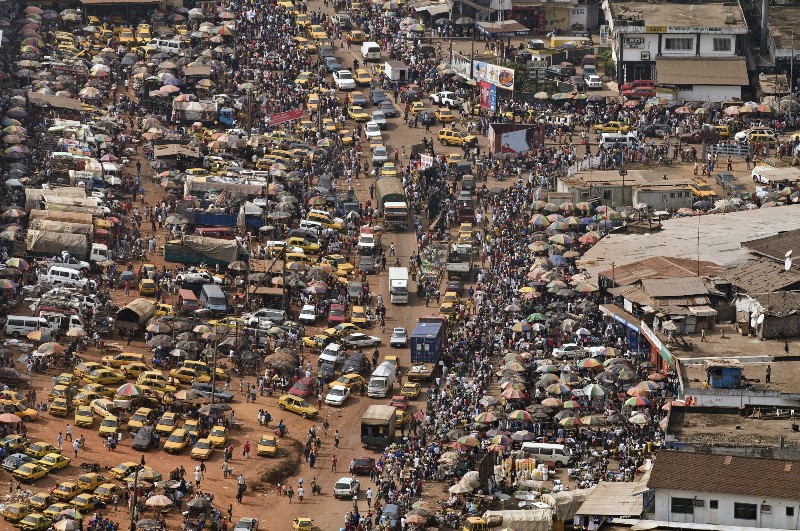As more power flows to cities, what role for science?
This article first appeared on the Habitat X Change blog as part of series undertaken in partnership with Future Earth. Habitat X Change is a collaborative space that connects science, visualisation and design for the future of cities. It will debut during the Habitat III summit in October in Quito, Ecuador. You can read more about this event here.
If you’re coming to Quito, join the Habitat X Change event with C40 and Seth Schultz October 20.
Read other stories from this series: "The time for science and cities to work together is now," "What data visualization can do for science" and "What role will science play in the future of cities?"
In this interview, Seth Schultz, Research Director at the C40 Cities Climate Leadership Group — a network of the world’s mega-cities committed to addressing climate change — talks about a new partnership emerging between science and cities. Boundaries between research and practice are dissolving in the pursuit of a common goal on sustainable urbanization. But a co-evolved approach requires stamina and long term thinking.
Q: You’re research director at C40. Could you explain what that involves, and how the meaning of the title is different from how it might be understood in academia?
Seth Schultz: What we do is research, measurement and planning. When Mayor Michael Bloomberg became the C40 Chair, we were mandated to create a stronger evidence base for the role that cities can play in tackling climate change and reducing greenhouse gas emissions.
About six years ago, we set out to articulate — what experts within the urban environment inherently knew but others didn’t — what the scope, impact and role of cities was in tackling climate change. So we created a coalition of organizations in this space, best practice and evidence on what the role of cities could be, why they should be involved, and what they could achieve.
It isn’t a traditional academic process where we’re looking to publish information and data in a way to get money to do more research. In fact it was quite the opposite.

Busan, Korea. Photo: UN
The research that we do must be action oriented, it is not meant to sit on a shelf, so the time frame is much shorter than the traditional academic process which is intended to be slower, more rigorous, more thoughtful. We have to move at the speed of politics. A mayor is on a four-year cycle.
Q: Can you give an example of this type of action-oriented research?
SS: Take mayoral powers, for instance. Urbanists understand what cities can do. But if you ask how or why you’ll get a lot of different answers. We created a new framework with which to assess the powers that cities had to implement action regarding climate change, something that had never been done before.
We identified four dimensions of power: to own and operate an asset, to provide legislative oversight, to provide vision and to control the budget. We mapped out all the emissions that come out from a city and broke these into 77 assets across those four dimensions, and then came up with a weighting system. Basically we created a new process and gathered data and information by surveying all of our member cities to understand exactly what they have the power to do.
This was a seminal piece of work which changed the landscape. For the first time, we were able to consistently say, across the world, and across countries and regions — what a similar or dissimilar set of powers does a city have. Instead of asking cities to do what they can’t, we were now able to ask them to do what they can. This meant we could be more strategic about the money we give cities, and the tasks we ask them to do. To get smarter about vertical integration in terms of the policy that needs to happen between local, national and regional governments. To figure out where they might need more power. Which level of government is best placed to execute what. That’s a really compelling conversation. We released a report last year on this topic titled “Powering Climate Action: Cities as Global Changemakers”

Monrovia, Liberia. Photo: UN/Christopher Herwif
Q: What are your goals for Habitat III?
SS: First, on the New Urban Agenda, we have worked hard to ensure recognition for cities, mayors and local governments in the text. The final draft agreed in New York earlier this month contains a role for local governments in its vision of sustainable urbanization that we are satisfied with. The other thing we were seeking in the New Urban Agenda was climate change as a strong and cross-cutting issue. This is more or less achieved for us, I’d say. Resilience and adaptation has always been a strong feature of the text, but mitigation was very weak, and now its a little better.
However, the vision of cities tackling climate change and reducing emissions in the world is still not as strong as it could be, so we feel this text does not permit a real implementation of the Paris Agreement at the urban level. The text could also have been stronger on linking all aspects of sustainable urban development — equity, social, prosperity, economic and environmental aspects. We will continue to work on these linkages, at both the research and advocacy levels.
Second, our goal at the Quito conference is to demonstrate how mayors are already implementing the New Urban Agenda. Mayors are already delivering a lot on local climate action, energy efficiency, sustainable transport, etc. In Quito, C40 will focus on exploring new projects: a discussion of climate and equity, how climate action helps reduce inequality in cities, urban food systems, and along with the International Council for Science we’ll be exploring a new dialogue emerging between cities and scientific research.
We’re also presenting a call to action to provoke a discussion with national governments to lead to a series of measure so mayors can get more support for their climate policies, to get much better access to climate finance specifically, and innovative finance more generally.
All in all, these goals can be summed up as trying to create and support the conditions for cities to deliver.
Q: What is the role of C40 in the Intergovernmental Panel on Climate Change (IPCC) and how has that changed since the Fifth Assessment Report?
SS: There was an acknowledgement coming out of AR5 and in the lead-up to COP21 that cities and other non-state actors would play a significant role in achieving the agreement that nations agreed to in Paris. One of the most compelling issues that motivated us to get involved was the lack of research in the IPCC that is policy relevant at the city level.
C40 and some of our other partners initiated a successful campaign after COP21, #CitiesIPCC to raise the profile of cities in the IPCC and support the proposal for an Special IPCC Report on Cities and Climate Change. This led to what we call “the IPCC decision on cities”, that gives cities a special focus in all AR-6 processes. Now that we have that recognition from the IPCC, we have the responsibility and the task to support that via evidence and data.
How do we use the political turning point of COP21 to implement action on the ground at a rapid pace? Cities are one of the few existing actors that are doing things already, and can do things even more rapidly. C40 and other city networks are going to be playing a huge role in the coming years.
At the 43rd session of the IPCC in Nairobi earlier this year, there was a decision to hold an international scientific conference on cities and climate change. C40, ICLEI, Cities Alliance, Future Earth and other urban stakeholders, submitted a proposal to co-organize it in early 2018. We are embarking on a long-term commitment to work directly with the research community to influence their agenda to support sustainable urbanization.
Q: This all sounds very timely and promising, but as we know the academic community works at a different pace from the practitioner community. How to bridge this gap to develop an effective working partnership?
SS: There’s a large debate going around the world right now on this very topic, the issue of time and academia. What is fit for purpose for the different entities, such as NGOs and consultant think tanks.
We are at a turning point. There is no question that more academic research needs to get turned into policy. At the same time policymakers need to be much more aware of the science and data. Organizations working on coupling those two things will come into prominence. A lot of consortia are being forged. For example we have created a new international initiative called the Coalition for Urban Transitions in partnership with the New Climate Economy and the World Resources Institute to bring together actors from academia, think tanks, banks and private sector companies all to churn out research — academic, and grey literature, and non-peer reviewed literature, private sector literature and policy literature — to address this issue as rapidly as possible. The coalition now has over 20 of the world’s foremost organizations working together in collaboration to address this. It is an incredible example of academics working with the private sector and with NGOs to accelerate learning and create a global evidence base for national leaders to understand the impacts of a rapidly urbanizing world.
I expect to see a proliferation of these types of bridging organizations, initiatives and mandates as we try to express the need and the gap around how to inject information and data into policy and politics. The social science of human systems is going to play a much larger role in the next decade or two. After all, cities are increasing in power and authority because that is where humanity is clustering.
DATE
October 6, 2016AUTHOR
Denise YoungSHARE WITH YOUR NETWORK
RELATED POSTS
Spotlight on LMICs – Tired of Breathing in Pollutants? Time for Better Fuel Economy and Vehicle Standards
Future Earth Taipei Holds 2024 Annual Symposium
Spotlight on LMICs – The Future’s Juggernaut: Positioning Research as Anchors for Environmental Health